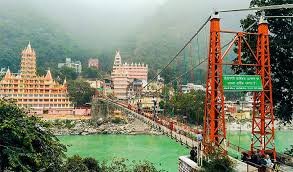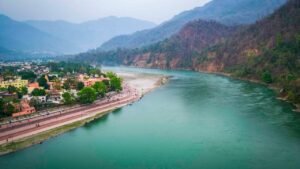Best Time to Visit Rishikesh – Weather, Travel Tips & My Experience of 2 days
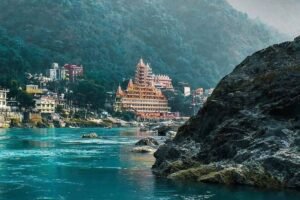
The serene Ganga River
Wondering when is the best time to visit Rishikesh? Discover the ideal season, weather conditions, and my personal travel experience. Avoid peak summer and plan your perfect Rishikesh trip with these expert travel tips!
Rishikesh, the Yoga Capital of the World, is a place that offers a mix of spirituality, adventure, and scenic beauty. But when is the best time to visit Rishikesh? If you’re planning a trip, choosing the right season is crucial to enjoy everything this holy city has to offer. I made the mistake of visiting in June, and let me tell you—it was not the best choice!
The heat was intense, and the crowds made it challenging to explore. But don’t worry! In this guide, I’ll share the best months to visit Rishikesh, what you should avoid, and how to make the most of your trip.
“It all started with a restless heart and a one-way ticket. Life in the city felt like a never-ending race, and I craved a place where time slowed down—where the mountains whispered stories and the river carried away all worries. That’s when Rishikesh called me. Not through a fancy travel brochure or an Instagram reel, but through an unshakable feeling that I needed to be there.
I still remember the first time I stepped onto the banks of the Ganges—the cool breeze, the scent of incense in the air, and the distant sound of temple bells. It wasn’t just another trip; it was an escape, a discovery, a journey that changed something deep within me. And now, I want to take you along on this adventure, to show you a side of Rishikesh beyond just yoga retreats and river rafting. Let’s explore the real magic of this place together!”
Introduction of Rishikesh
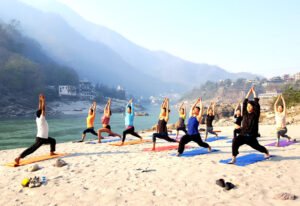
There’s something about Rishikesh that words can’t quite capture—something you feel the moment you arrive. Maybe it’s the way the emerald-green Ganges flows fearlessly through the Himalayan foothills, or how the distant hum of temple bells blends with the laughter of travelers seeking peace, adventure, or both.
Known as the “Yoga Capital of the World,” Rishikesh is more than just a spiritual retreat. It’s where ancient wisdom meets adrenaline-pumping experiences. From soul-stirring Ganga Aarti at Triveni Ghat to white-water rafting in the roaring rapids, this city is a playground for seekers, wanderers, and thrill-seekers alike.
I came here expecting a weekend getaway, but Rishikesh had other plans. The sunrise over Lakshman Jhula, the scent of fresh chai by the river, the quiet moments in an ashram—each experience felt like a reminder to slow down and breathe. Whether you come for yoga retreats, adventure sports, or a soul-refreshing escape, Rishikesh welcomes you with open arms.
Best Time To Visit Rishikesh
My Experience Visiting Rishikesh in June
I arrived in Rishikesh with excitement bubbling inside me, imagining peaceful mornings by the Ganges, thrilling adventures, and soul-soothing sunsets. But reality had a different plan. June in Rishikesh is peak summer, and the heat was relentless. Daytime temperatures hovered between 35-40°C (95-104°F), and stepping out in the afternoon felt like walking into an oven. The sun was merciless, making long walks, sightseeing, and even yoga sessions feel exhausting.
I had dreams of trekking to Neer Garh Waterfall and enjoying a peaceful Ganga Aarti at Triveni Ghat, but the sweltering heat drained my energy quickly. Even river rafting, which I had been most excited about, felt more like surviving the heat than enjoying the thrill. The only relief? Cool dips in the Ganges and chilling at riverfront cafés like Little Buddha Café, sipping fresh juices while escaping the heat.
When is the Best Time to Visit Rishikesh?
After experiencing the harsh summer firsthand, I’d highly recommend visiting between September and March. Here’s why:
-
October to March (Winter & Early Spring) – Best Time
Pleasant weather (10-25°C) for sightseeing, adventure sports, and yoga
Ideal for rafting, trekking, and exploring nature
Spiritual vibes are at their peak with peaceful ashram stays -
July to September (Monsoon) – Avoid or Plan Wisely
Heavy rains can lead to landslides and strong river currents
Rafting is usually closed due to safety concerns
Beautiful lush green scenery but risky travel conditions -
April to June (Summer) – Think Twice
Too hot for outdoor activities during the day (35-40°C)
Can get crowded with tourists looking for pre-monsoon rafting
River rafting is still open, but extreme heat can be uncomfortable. - Although evenings were pleasant in summer .
Learn from My Mistake
If you love adventure and spiritual retreats, plan your Rishikesh trip between October and March for the best experience. Avoid June unless you’re ready to brave the heat! If you still visit during summer, stick to early mornings and late evenings for activities, and spend afternoons in cafés or near the river.
Would I visit Rishikesh in June again? Probably not. But would I return during winter? Absolutely!
Top Attractions in Rishikesh: Lakshman Jhula & Ram Jhula
1) Lakshman Jhula – More Than Just a Bridge, An Experience
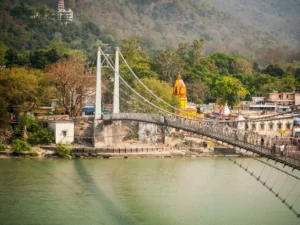
Scenic view of Ram Jhula, the iconic suspension bridge
If there’s one place in Rishikesh that’s as iconic as the Ganges itself, it’s Lakshman Jhula. This 450-feet-long iron suspension bridge sways gently over the river, connecting Tapovan to Jonk vill
Tage and offering breathtaking views of the holy town. But let me be honest—my experience here was far from peaceful.
I visited in June, hoping to soak in the spiritual vibe, but instead, I found myself caught in a crowd of tourists, bikers, and even cows making their way across! The scorching sun added to the challenge, making the walk across the bridge feel longer than it actually was. The bridge is only 2 meters wide, so squeezing through the crowd while dodging scooters honking their way through was quite the adventure.
A Sip of Relief: Beating the Heat Near Lakshman Jhula
As I stepped off the bridge, my first thought was: “I need something cold, right now!” Thankfully, Rishikesh has the perfect answer—Bel Ka Sharbat and Fresh Lime Juice. Just a few steps from the bridge, street vendors sell refreshing drinks for ₹20-₹50, and let me tell you, that first sip of Bel juice felt like a blessing in the heat. Tangy, sweet, and ice-cold—it was exactly what I needed.
Beware: Pickpockets & Chain Snatchers
While I was soaking in the sights, I overheard a local shopkeeper warning a tourist about pickpockets and chain snatchers. With the heavy crowd, it’s easy to get distracted, and thieves take full advantage of that. Keep your bags zipped, avoid carrying valuables openly, and if you wear jewelry, be extra cautious.
How I Felt at Lakshman Jhula
I won’t lie—it was overwhelming at first. The heat, the crowd, and the constant movement made it hard to just stand and take in the beauty of the place. But amidst the chaos, there was a strange sense of energy—the sound of temple bells, the cool breeze from the river, the sight of monks walking peacefully while tourists clicked selfies. It was a mix of spiritual serenity and chaotic city life, all blended into one.
Would I visit Lakshman Jhula again? Yes, but definitely not in peak summer! If you’re planning to go, visit early in the morning or late in the evening to avoid the rush and truly enjoy the spiritual aura of this historic spot.
Next, I headed towards Ram Jhula, hoping for a more peaceful experience… (but that’s a story for another section!)
Visiting Rishikesh with Kids: Tips for Parents
Rishikesh can be an exciting yet challenging destination if you’re traveling with kids. While the spiritual and adventurous vibes are unmatched, the crowded areas, uneven paths, and extreme weather can make it tricky for parents. Here’s how to make your trip safe, fun, and comfortable for your little ones.
1. Best Guide to Visiting Ram Jhula with Kids | Travel Tips & Safety
October to March – Pleasant weather, fewer crowds, perfect for outdoor activities
Avoid April to June – Too hot,or raining, kids may feel exhausted quickly
Monsoon (July-Sept) – Slippery roads and water sports might be closed
2. How to Reach Rishikesh – Best Travel Options
-
By Air: Fly to Dehradun’s Jolly Grant Airport (21 km from Rishikesh) and take a cab (best for avoiding long travel hours).
-
By Train: Arrive at Haridwar Junction and take a taxi to Rishikesh.
-
By Road: If driving from Delhi or Dehradun, take frequent breaks for food and rest.
Tip: If traveling by car, carry motion sickness tablets and avoid long road journeys during extreme heat.
3. Fun & Kid-Friendly Things to Do
-
Ganga Aarti at Triveni Ghat – A mesmerizing experience that kids will love!
-
Neer Garh Waterfall – A short, easy trek with refreshing water.
-
Beatles Ashram – Wide open spaces for kids to explore.
-
Parmarth Niketan – A peaceful ashram with open grounds.
Avoid crowded suspension bridges (Lakshman & Ram Jhula) during peak hours.
4. Food & Hydration Tips
-
Carry snacks, fruits, and ORS packets for hydration.
-
Try fresh fruit juices (Bel Ka Sharbat, Lemon Water) to keep them cool.
-
Visit cafés with kid-friendly menus like Chotiwala, Little Buddha Café, and The Sitting Elephant.
5. Safety Tips for Parents
Hold hands tightly when walking on Lakshman Jhula or busy streets—it’s easy to get separated in crowds.
Avoid letting kids near the river banks alone. The Ganges has a strong current.
Apply sunscreen and carry hats & sunglasses to protect kids from heat.
Carry a refillable water bottle to avoid dehydration.
Final Thoughts: Is Rishikesh Good for a Family Trip?
Yes, but plan wisely! Choose the right season, pick kid-friendly attractions, and ensure safety near water bodies and crowded areas. With the right approach, Rishikesh can be an amazing spiritual and nature retreat for families!
Would you like suggestions on specific hotels or ashrams that are family-friendly?
Visiting Ram Jhula with Kids: A Parent’s Guide
Ram Jhula is one of Rishikesh’s iconic suspension bridges, offering stunning river views and access to famous ashrams and markets. However, if you’re visiting with kids, navigating the crowds, narrow pathways, and occasional two-wheeler traffic can be a challenge. Here are some practical tips to make your visit smooth and enjoyable.
1. Best Time to Visit with Kids
-
Early Morning (6 AM – 9 AM) – Fewer crowds, peaceful atmosphere, and pleasant weather.
-
Evening (5 PM – 7 PM) – Cooler temperatures, beautiful sunset views, and time to experience the nearby Ganga Aarti.
-
Avoid afternoons (especially in summer, April–June) as it gets extremely hot.
2. How to Reach Ram Jhula with Kids
-
By Taxi/Auto – Best option if traveling with small children. Autos drop you close to the bridge.
-
By Foot – If kids enjoy walking, you can take a short scenic walk from Parmarth Niketan or Swarg Ashram.
-
By Boat (Best for Kids!) – Instead of crossing the bridge, take a boat ride across the Ganges (₹20-₹50 per person) for a fun and easy experience.
Pro Tip: If you have a stroller, avoid taking it on the bridge—it’s difficult to navigate due to the crowd. Instead, use a baby carrier for toddlers.
3. What to Do at Ram Jhula with Kids
- Enjoy the View – Kids will love spotting boats, temples, and the river from the bridge.
- Visit Nearby Ashrams – Parmarth Niketan & Gita Bhawan have open areas where kids can roam freely.
- Take a Boat Ride – A quick and scenic way to cross the river without the bridge hassle
- . Try Local Snacks – Bel Ka Sharbat, fresh juices, and lassi are great for cooling down.
- Avoid: Letting kids walk alone, as pickpockets and monkeys can be an issue.
4. Safety Tips for Parents
Hold hands tightly – The bridge can shake slightly, and bikes sometimes pass through. Keep kids away from the river’s edge – The Ganges has a strong current. Carry essentials – Sunscreen, hats, extra water, and snacks. Beware of Monkeys! – Avoid carrying food in hand; monkeys might snatch it.
5. Best Family-Friendly Places Near Ram Jhula
-
Parmarth Niketan Ashram – Great for kids to relax and explore.
-
Chotiwala Restaurant – Iconic place for hygienic, kid-friendly meals.
-
Triveni Ghat – A must-visit for the evening Ganga Aarti.
Final Thoughts: Is Ram Jhula Good for Families?
Yes, but plan wisely. Visit at off-peak hours, keep safety in mind, and try the boat ride for an easy, fun experience. If you have a toddler, stick to nearby attractions rather than walking too much in the heat.
Triveni Ghat – The Magical Experience of Evening Ganga Aarti in Rishikesh
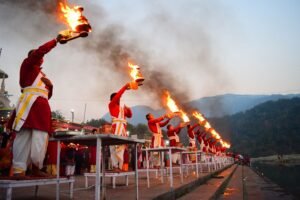
A sacred riverbank where the Ganga Aarti takes place, offering a mesmerizing spiritual experience with glowing lamps, holy chants, and the serene flow of the Ganges.”
If there’s one experience in Rishikesh that stays with you forever, it’s the Ganga Aarti at Triveni Ghat. It’s not just a ritual; it’s a moment of deep spirituality, devotion, and breathtaking beauty. The flickering flames, the sound of ringing bells, the powerful chants—it all comes together in a way that makes you feel something beyond words.
But to truly enjoy this divine moment, you need to plan your visit right. Here’s everything you need to know about Triveni Ghat’s Ganga Aarti, the best time to go, and my personal experience witnessing this mesmerizing event.
Best Time to Visit Triveni Ghat for Evening Ganga Aarti
If you want to get a good spot and experience the Aarti fully, you should reach by 5:30 PM. The actual Aarti starts around 6:30 – 7:00 PM (timing varies slightly by season).
- Winter (Oct – Feb): Aarti usually starts around 6:00 PM
- Summer (March – June): Aarti begins around 7:00 PM
- Monsoon (July – Sept): Timings may change due to weather, so check locally
Pro Tip: The place gets very crowded, especially on weekends and festivals. Arriving early helps you find a comfortable spot.
My Personal Experience of Ganga Aarti at Triveni Ghat
As my husband and I walked towards Triveni Ghat, we could already hear the rhythmic sounds of bhajans (devotional songs) filling the air. The moment we stepped in, the sight was surreal—thousands of devotees sitting by the riverbank, priests preparing the grand brass lamps, and the holy Ganges flowing calmly in front of us.
We managed to get a front-row spot by reaching early, and I highly recommend it! Just sitting there, feeling the cool evening breeze and watching the preparations, was a spiritual experience in itself.
As soon as the Aarti began, everything else faded away. The priests, dressed in saffron robes, raised their huge multi-tiered brass diyas, moving them in synchronized motions to the chants of “Om Jai Gange Mata.” The flames reflected beautifully on the river, creating a golden glow. In that moment, I felt completely lost in the energy of the place—overwhelmed, grateful, and peaceful all at once.
After the Aarti, we both sat quietly for a few minutes, soaking in the divine energy. My husband turned to me and said, “This is something we’ll never forget.” And he was absolutely right.
How to Manage with Kids at Triveni Ghat
If you’re traveling with kids, here are some must-know tips to ensure a smooth experience:
Arrive Early – The front area fills up quickly; arriving at least an hour early helps you settle down before the rush.
Carry Essentials – Water, light snacks, and a hand fan if visiting in summer.
Beware of Monkeys! – They might grab food or belongings. Keep your bags closed.
Noise Sensitivity – If your child is sensitive to loud sounds, bring earmuffs or cotton to reduce the noise level.
Try a Boat Ride Before the Aarti – This keeps kids engaged and excited before the ceremony begins.
What I Felt After Attending Ganga Aarti at Triveni Ghat
Devotees singing bhajans and dancing at Triveni Ghat, Rishikesh – A vibrant spiritual gathering by the Ganges, filled with devotion, music, and the energy of the sacred Ganga Aarti.”
After the Aarti ended, I couldn’t help but feel lighter, calmer, and deeply connected to something bigger than myself. Watching hundreds of diyas floating on the Ganges, carrying prayers and wishes of so many people, was a sight I’ll never forget.
It wasn’t just about religion—it was about faith, devotion, and the realization that sometimes, you just need to pause and absorb the beauty around you. My husband and I sat there for a while, talking about how powerful and pure the experience felt. It was a moment of complete stillness, something rare in our fast-moving lives.
Would I recommend this to others? Absolutely. No matter your beliefs, this is something that will touch your soul.
Devotees singing bhajans and dancing at Triveni Ghat, Rishikesh, during the evening Ganga Aarti – a soulful blend of devotion, music, and spiritual energy by the sacred Ganges
Final Tips for the Best Ganga Aarti Experience
- Reach by 5:30 PM to get a good spot
- Sit on the steps near the main Aarti area for the best view
- Avoid weekends if you prefer less crowd
- Stay back after the Aarti to experience the peaceful atmosphere
Have you ever attended the Ganga Aarti? If not, make sure to add it to your travel bucket list! If yes tell me your experience !
The moment we decided to visit Neelkanth Mahadev Temple, I knew it wasn’t just another sightseeing spot. It was a journey—one that would take us through lush green forests, winding mountain roads, and deep into the heart of Shiva’s presence.
But what made this visit even more special? My little one’s curious mind.
As we drove through the scenic hills of Rishikesh, my child looked out of the window, fascinated by the towering trees and the misty mountains.
“Mama, why is this temple called Neelkanth?” he asked.
I smiled, knowing that I was about to share one of the most powerful mythological stories with him—one that had been told for generations.
The Spiritual Significance of Neelkanth Mahadev Temple
I turned back to my little one and began,
“A long time ago, when the gods and demons churned the ocean for nectar, a dangerous poison called ‘Halahala’ emerged. It was so powerful that it could destroy everything. The gods were scared, and no one knew what to do. But Lord Shiva, being the protector of the universe, drank the poison to save everyone. He didn’t swallow it, though—he held it in his throat. The poison turned his throat blue, and from that day, he was called Neelkanth, the Blue-Throated One.”
His eyes widened with wonder.
“So, this is where it happened?” he asked.
“Yes, my love. This is where Shiva meditated after drinking the poison. That’s why people come here—to feel his presence and seek his blessings.”

Neelkanth Mahadev Temple, Rishikesh – A sacred Shiva temple nestled in the Himalayas, known for its stunning architecture, spiritual significance, and serene surroundings.
How to Reach Neelkanth Mahadev Temple
Location: 32 km from Rishikesh, hidden deep in the Pauri Garhwal mountains.
By Taxi: The most comfortable option. A round-trip taxi from Rishikesh costs ₹1500-₹2000.
By Bike/Scooter: If you love adventure, rent a bike and ride through the stunning hills.
By Trekking: A 12 km scenic trek from Ram Jhula, perfect for nature lovers.
Pro Tip: If traveling with kids, opt for a taxi. The road is curvy, so carrying light snacks and motion sickness medicine is a good idea.
My Experience at Neelkanth Mahadev Temple
The moment we stepped inside the temple complex, I felt an overwhelming sense of calm. The air was filled with the scent of incense, the soft chanting of mantras, and the sound of temple bells echoing through the valley.
We joined the queue to offer prayers. The Shivalinga inside was beautifully decorated with flowers, milk, and Bilva leaves. I whispered a silent prayer, thanking the universe for this experience.
As my husband and I closed our eyes for a moment, my son tugged at my hand.
“Mama, can I ask for something?”
“Of course, sweetheart. What do you want to pray for?”
He folded his little hands and said, “I just want everyone to be happy.”** That moment melted my heart.
How to Manage with Kids at Neelkanth Mahadev Temple
Explain the story – Kids love hearing about gods as superheroes!
Avoid peak hours – Try visiting early morning (before 9 AM) to avoid crowds.
Carry snacks & water – There are a few food stalls, but it’s best to carry something for kids.
Beware of monkeys! – They love grabbing food, so keep everything in closed bags.
Why You Should Visit Neelkanth Mahadev Temple
As we walked out of the temple, my son turned to me and said,
“Mama, Lord Shiva must be so strong to hold all that poison. But I think he was also very kind.”
And in that moment, I knew that our visit wasn’t just a trip—it was an experience that had left a mark on our hearts.
Neelkanth Mahadev Temple is more than just a place of worship. It’s a journey through faith, nature, and inner peace. If you’re in Rishikesh, don’t miss the chance to feel its magic.
Parmarth Niketan & Other Ashrams – Yoga and meditation centers
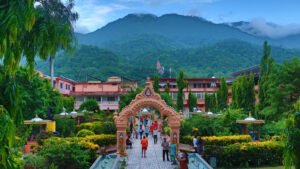
“Parmarth Niketan Ashram, Rishikesh – A renowned spiritual retreat on the banks of the Ganges, offering yoga, meditation, and the famous Ganga Aarti for seekers of peace and enlightenment.”
As we entered Parmarth Niketan, the largest ashram in Rishikesh, I felt an immediate sense of tranquility. Lush gardens, sacred statues, and the flowing Ganga created a perfect retreat from the chaos of everyday life.
“Why do people come here?” my son asked, looking around curiously.
“Some come to learn yoga, some to meditate, and some to just breathe and be still,” I said, watching a group of people stretching in a morning yoga session. The ashram offers daily yoga classes, spiritual lectures, and evening Ganga Aarti—a magical prayer ceremony by the river.
“Can kids come too?”
“Of course! You’ll learn mindfulness, focus, and even fun yoga poses!”
Parmarth Niketan hosts the International Yoga Festival every March, drawing people from all over the world. Whether you’re a beginner or a yogi, there’s something for everyone.
Is It Worth Visiting?
My husband, still skeptical, asked, “So, is this really worth the visit?”
“Absolutely! Imagine a place where you can disconnect from stress, focus on your well-being, and soak in the positive energy of the Himalayas.”
Even if you’re not into meditation, the peaceful environment, breathtaking views, and soulful atmosphere make it a unique experience.
What Can a Child Learn from an Ashram?
“But what’s in it for me?” my little one asked.
“More than you can imagine!” I smiled.
Mindfulness & Focus – Learning to be present in the moment.
Simple Living – Understanding happiness beyond material things.
Discipline – Yoga teaches patience and self-control.
Kindness & Compassion – Being surrounded by positive energy and selfless service.
“So, I get to do yoga and watch the Ganga Aarti?” he asked, excited.
“Yes! And maybe even meet a real-life yogi!”
Are There Any Charges?
Parmarth Niketan: Donations-based stays, yoga programs start from ₹500 – ₹5000 per day depending on accommodation.
Other Ashrams: Some offer free meditation, while structured retreats may cost up to ₹2000 – ₹10,000 per program.
A Journey Worth Taking
As the sun set, we joined the Ganga Aarti at Parmarth Niketan, watching the flames dance in the cool evening breeze. The chants filled the air, and for a moment, everything felt perfect.
“Maybe I should try yoga too,” my husband admitted, stretching his arms.
“Maybe we all should,” I said, smiling.
Because in places like this, you don’t just learn yoga—you learn a new way of life.
Farewell, Rishikesh – Until We Meet Again!
As we took one last look at the flowing Ganges, the sun dipping behind the hills, a wave of calm washed over us. Leaving Rishikesh wasn’t just about ending a trip; it felt like stepping away from a world where time slows down, where the river whispers stories, and where adventure and peace exist in perfect harmony.
My husband and I laughed as we made a promise—“One day, when we’re old, we’ll keep coming back here.” Maybe we’ll sit by the river, reliving our wild adventures, or maybe we’ll just enjoy the silence that makes this place so special.
But for now, it’s your turn. Have you been to Rishikesh? What was your favorite experience? I’d love to hear your stories! And if you’re planning your first trip, stay tuned—my adventure-packed Rishikesh blog is coming soon, with all the best tips, experiences, and hidden gems! Let’s keep the spirit of Rishikesh alive, one story at a time.







